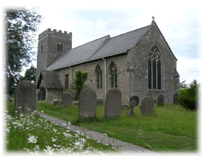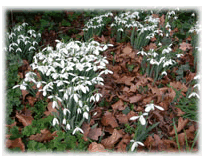Conservation
Churches have long been recognised as sanctuaries. Now with the decrease of natural wildlife habitats, our churchyards are increasingly seen as sanctuaries for wildlife, providing refuge for many varieties of plants and animals.

 St Oswald’s Church in June
St Oswald’s Church in JuneWith the agreement of the Parochial Church Council, the conservation of Finningley old churchyard began in 1994. A number of surveys were carried out and a surprisingly large number of different species of flowering plants and grasses were identified.
A management plan was drawn up. Under this plan parts of the churchyard are conserved as spring meadow, not cut until July, and parts are conserved as summer meadow, not cut until September. Other areas are kept mown recognising the needs of people visiting the church and providing access to graves.
Some trees, shrubs and wild flowers were introduced in the first few years to create extra sources of food (nectar and berries) and habitats for wildlife. Bird boxes were put up, log piles were created and 2 compost heaps have been maintained within the churchyard, all with the aim of attracting a variety of small animal, bird and insect life.

 Snowdrops
SnowdropsOver the years these measures have increased the number and variety of wild flowers, benefited wildlife and enhanced the natural appearance of the churchyard.
Snowdrops are the first flowers to appear in January, followed by the early spring flowers, Primroses, Violets and Daffodils. Later plants that attract spring butterflies come into flower such as Honesty, Garlic Mustard and Lady’s Smock, a flower of damp meadows, a rarity in the dry sandy soils of our area.
Buttercups, Sorrel, Plantains and Sweet Vernal Grass, plants of the spring meadow are next to flower. Bridging the gap between spring and summer Ox-eye Daisies, Germander Speedwell with its tiny bright blue flowers and Lady’s Bedstraw with its soft sulphur-yellow flowers bring colour throughout the churchyard. Lesser Knapweed with its purple thistle-like flowers, Yarrow, Harebells with their dainty pale blue nodding bells and the cheerful candy-striped flowers of Field Bindweed are all to be found in the summer meadow. In late summer the breeze rippling through the ripening grasses illuminated by the evening sun is especially beautiful. In autumn after most of the grasses have been cut down the trees and shrubs brighten up the churchyard with their scarlet berries and hips. Varieties of fungi now begin to appear and the Ivy that covers the walls is itself in flower and alive with the buzzing of insects, bees and butterflies taking their fill before hibernation.
Our work in conserving the churchyard has received recognition from Doncaster Naturalists’ Society, DMBC, English Nature and the Yorkshire Wildlife Trust. We gained awards in 1997 and 1999 in the environmental category of the “Doncaster in Bloom” competition and since 2000 we have gained awards and recognition from Yorkshire Wildlife Trust in maintaining a churchyard that is “managed most sympathetically for wildlife”.
Conservation does not imply a policy of neglect and lack of care. It does mean a change of emphasis, adopting a sensitive and balanced approach so that the churchyard is managed for the benefit of all.

